You might be someone wanting to grow indoor trees or tree-like plants in your house due to the ample space. But choosing the best indoor trees can be a daunting experience if your living space receives low light from the sun.
We recommend going for low-light indoor trees to liven up your living space. My favorite indoor trees for low-light are rubber plants, dragon trees, lady palms, parlor palms, Alii ficus, and corn plants.
Picking the best low-light indoor trees may sound simple, but you need to know one or two things before buying. Below are our picks of 20 beautiful low-light indoor trees you need in your living space.
Factors to Consider Before Buying Indoor Trees
Cost
The cost of different indoor trees depends on the size. Large indoor trees are more expensive than their smaller counterparts. If you’re looking for tall tree-like plants, you’ll part with a good amount of money.
Pets
Most pets (cats and Dogs) can pose a threat to your indoor trees. Some indoor trees can be toxic or non-toxic to your pets. We recommend confirming the toxicity of your tree before taking it home. (Source: ASPCA)
Children
Another consideration you will have to make involves your children. Toddlers are more curious and love to explore. Some children might ingest the leaves or bite the stems to peel the bark.
Most indoor trees are mildly toxic; they can make your children fall sick. It is worth considering the plant toxicity before buying. Besides that, put the plant on the top shelf away from children.
Room Conditions
Different types of indoor trees require specific growing conditions. Some indoor tree species require indirect sunlight, low or high temperature, and high humidity. It is worth noting your room condition before buying an indoor tree.
Ease to Grow and Maintain
Houseplants come in different forms, some being easy to grow and maintain. We recommend understanding the indoor tree care routines before taking them home. Some indoor trees can be neglected for an extended period, and others cannot.
Different Types of Low Light Indoor Trees
Different types of houseplants have specific lighting requirements. Some indoor plants require bright lighting conditions, while others dim-light environments to thrive well. Below is a list of tall and large indoor trees for low light:
Madagascar Dragon Tree (Dracaena Marginata)
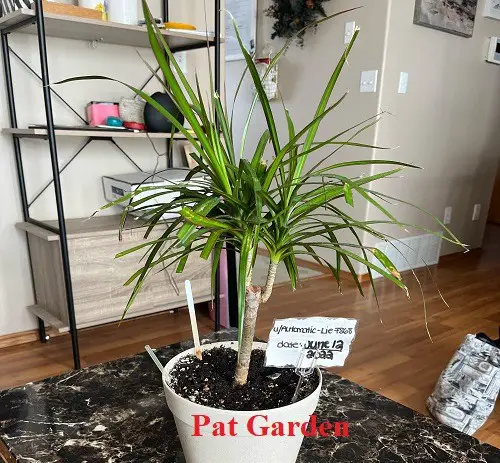
A dragon tree is a perfect choice for making a statement in your living space due to the live greenery and red blood oozing when it’s cut.
The short and sturdy stems help prevent the provision of additional support when this low-light indoor tree grows into a mature height.
The maximum height for an indoor Madagascar dragon tree ranges from 6ft to 10ft. The slender leaves appear at the top only and not along the trunk.
Place the dragon tree near a north-facing window to receive low light during the day. Do not place the tree near the east or west-facing window to avoid sun scorching.
Be sure to keep the soil moist and not soggy to avoid root rot. Besides that, provide high humidity and maintain a temperature range of 60-75oF.
| Maximum Height | 6-10ft |
| Light Requirements | Low indirect sunlight |
| Water Requirements | Keep the soil moist |
| Indoor Benefits | Beautification and removal of toxins in the air. |
| Native | Madagascar |
Rubber Plant (Ficus Elastica)

Rubber plants are tropical evergreen plants that can flourish indoors and outdoor. The plant can also tolerate low lighting conditions when grown indoors.
These plants have broad and waxy leaves that make a bold statement in your indoor forest. The leaves can be deep green, tricolor, or black due to their different varieties.
Indoor rubber plants can reach 6-10ft tall to match the available living space. We recommend buying larger rubber plants since they are already established.
Ensure the potting soil is moist and never soggy to encourage proper growth. Rubber plants are readily available in many plant stores.
| Maximum Height | 6-10ft tall |
| Light Requirements | Medium to low light |
| Water Requirements | Keep the soil moist |
| Indoor Benefits | Remove toxins from the air |
| Native | India and Malaysia |
Money Tree (Pachira Aquatica)
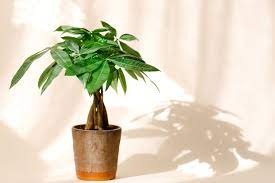
It is another low-maintenance houseplant with attractive foliages. The bright-green five-lobed leaves are known to bring fortune to your home.
The trunks are braided while still young and later turn woody to bring an extra decorative appearance. The plant requires high humidity to maintain foliage vigor.
The money tree is also called water chestnut and Guiana chestnut. It can reach 5ft tall and spread to 1ft.
| Maximum Height | 5ft |
| Light Requirements | Bright indirect sunlight |
| Water Requirements | Moist soil and never soggy |
| Indoor Benefits | Freshen indoor air by removing toxins |
| Native | China |
Corn Plant (Dracaena Fragrans)
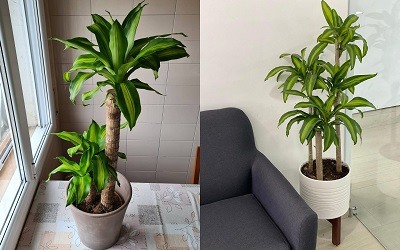
It is a tender shrub that grows from a central trunk with branches of broad sword-shaped foliages. The pointed leaves are shiny with features of variegated light and dark green striped design.
Corn plant hails from tropical Africa and thrives well in a condition with controlled temperatures. Keep the plant away from cold air sources and heating vents to avoid temperature stress effects.
| Maximum Height | 5-6ft |
| Light Requirements | Scattered light |
| Water Requirements | Moist soil |
| Indoor Benefits | Decorative appeal |
| Native | Africa |
Lady Palm Tree (Rhapis Excelsa)
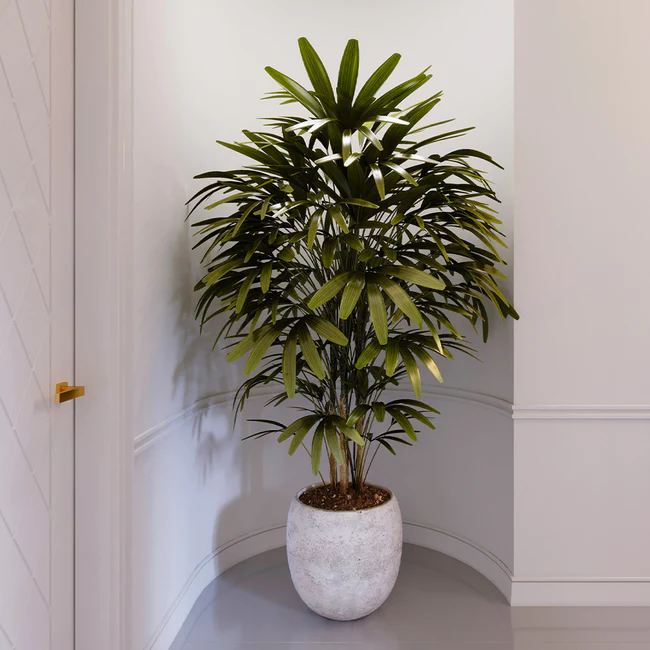
It is a slow-growing beauty plant that can tolerate low light and household temperature dynamics. This indoor tree has fan-like fronds that match its small size.
We recommend slotting the lady palm tree in a corner for the shiny green fronds to fill the available space. Mature lady palm trees can tolerate neglect for an extended time.
Feed your indoor lady palm tree with houseplant fertilizer in the spring and summer weather. Occasional pruning help to get rid of old fronds and maintain shape.
| Maximum Height | 3-10ft |
| Light Requirements | Indirect sunlight |
| Water Requirements | Moist soil |
| Indoor Benefits | Improve indoor appear |
| Native | Southern China and Taiwan |
Dumb Cane (Dieffenbachia Amoena)
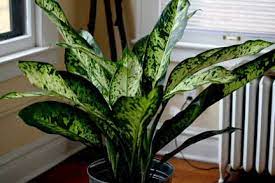
It is another famous indoor tree that can thrive under low-lighting conditions. Dumb cane plants experience a slow-growing rate due to the low-lighting effect.
Dumb cane plant hails from West Indies and will flower under the right conditions. But these flowers are usually unimpressive though the foliages come with unique patterns.
The indoor tree is toxic to pets and children when ingested. We recommend keeping the houseplant away from pets and toddlers.
| Maximum Height | 6ft |
| Light Requirements | Indirect sunlight exposure |
| Water Requirements | Moist soil |
| Indoor Benefits | Improve living space appeal |
| Native | West Indies |
Kentia Palm Tree (Howea forsteriana)
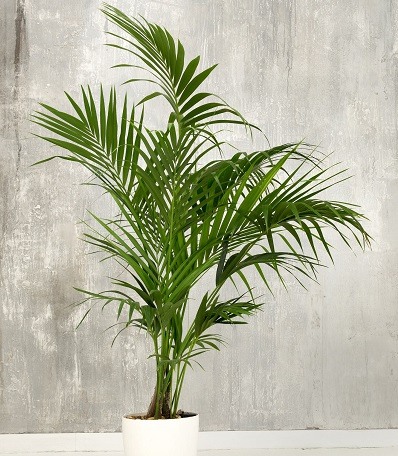
Kentia palm tree is a symbol of wealth status as seen in Victorian drawing rooms and cafés. The palm tree has numerous stems planted closely together in a pot or container.
These stems create a tiered effect with long green feather-like leaves hanging in a graceful arch. The houseplant is native to the Australian east coast.
Kentia palm tree thrives in high humidity and balmy temperatures. It is also called paradise palm or thatch palm.
| Maximum Height | 6-10ft |
| Light Requirements | Indirect sunlight |
| Water Requirements | Moist soil |
| Indoor Benefits | Make a statement in the indoor space |
| Native | Lord Howe Island |
Umbrella Tree (Schefflera Actinophylla)

Indoor umbrella trees can reach 4-6ft tall under low-lighting conditions. The tree can also tolerate bright indirect sunlight and not direct exposure.
We recommend rotating the indoor umbrella tree to prevent it from leaning towards the light when growing. Position your umbrella tree near the southern or east-facing window.
Some popular umbrella tree varieties are compacta, dazzle, gold Capella, green gold, and trenette.
| Maximum Height | 4-6ft |
| Light Requirements | Indirect sunlight exposure |
| Water Requirements | Moist soil |
| Indoor Benefits | Improve indoor appeal |
| Native | Australia |
Norfolk Island Pine (Araucaria Heterophylla)
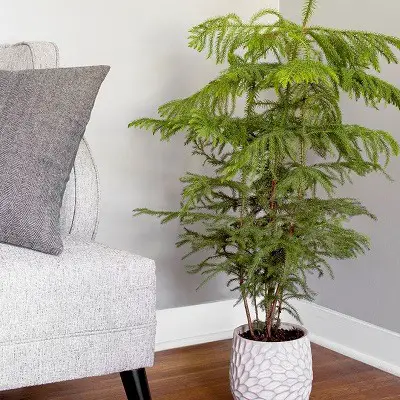
Norfolk Island pine is an indoor tree that brings tropical zest and Christmas cheer to any living space. The straight slender trunks with delicate needle-like foliages help improve indoor décor.
The plant requires high humidity throughout the year to prevent the leaves from drooping or turning brown. We recommend misting the plant or investing in an electric humidifier.
| Maximum Height | 3-8ft |
| Light Requirements | Indirect sunlight exposure |
| Water Requirements | Moist soil |
| Indoor Benefits | Improve indoor decor |
| Native | Norfolk Island |
Australian Tree Fern (Dicksonia Antarctica)
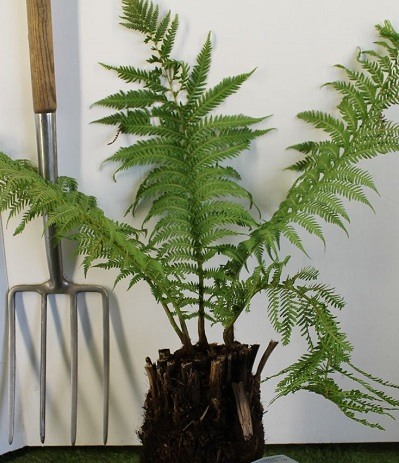
It is a slow-growing semi-evergreen tree with attractive terminal rosette and glossy dark green fronds. The stout trunk covered with soft reddish brown hairs can reach 10ft tall.
We recommend misting the plant weekly to boost humidity and encourage a healthy growth rate. Another option is to invest in an electric humidifier instead of misting.
| Maximum Height | 10ft |
| Light Requirements | Bright to dim indirect sunlight |
| Water Requirements | Moist soil |
| Indoor Benefits | Improve decor |
| Native | Australia |
Fishtail Palm (Caryota Mitis)
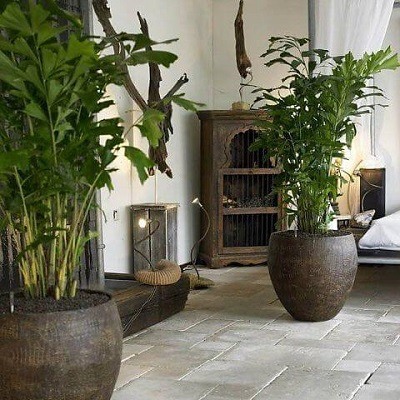
The rough edges and ribbed textures of the foliages are the reasons for the name fishtail palm tree. It grows in a dense clump of stems producing dark-green triangular foliages that split at maturity.
Fishtail palms are native to tropical Asia with mid-high humidity conditions. We recommend protecting the plant from cold and hot drafts. It is also called the Burmese fishtail palm tree.
| Maximum Height | 6ft |
| Light Requirements | Low to moderate sunlight exposure |
| Water Requirements | Moist |
| Indoor Benefits | Improve indoor decor |
| Native | Asia |
Bird Of Paradise (Strelitzia Reginae)

Bird of paradise makes an exotic statement in the living space. Thanks to the show-stopping flowers and ability to tolerate low-lighting conditions.
The large green oval leaves with blossoms of blue and orange make these tropical indoor trees outstanding. It requires high humidity to maintain its attractive appearance.
Bird of paradise hails from South Africa due to the tropical growing conditions. It is also known as the crane flower or queen bird of paradise.
| Maximum Height | 5ft |
| Light Requirements | Low light |
| Water Requirements | Moist soil |
| Indoor Benefits | Improve décor and remove toxins from the air. |
| Native | South Africa |
False Aralia (Schefflera Elegantissima)
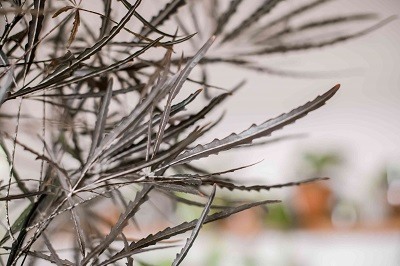
False aralia hails from Polynesia and New Caledonia. It grows tall with densely textured foliages from the soil to the tip.
The finger-like narrow dark-green leaves with serrated edges make the plant create tropical forest vibes in your living space.
Low temperatures and humidity can make the plant’s delicate leaves droop. Besides that, prolonged exposure to low light can make the stems leggy.
| Maximum Height | 4ft |
| Light Requirements | Low to moderate sunlight exposure |
| Water Requirements | Moist soil |
| Indoor Benefits | Tropical forest vibe |
| Native | Polynesia and New Caledonia |
Striped Dracaena (Dracaena Deremensis)
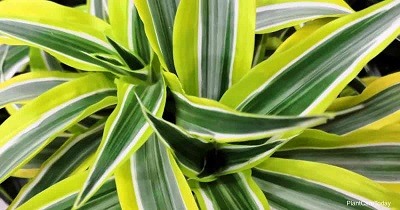
It has an erected central trunk with clusters of long lance-shaped foliages meeting at the branches. The leaves have eye-catching narrow stripes of gray, green, and cream.
Striped dracaena plants are native to Africa and Southern Asia. We recommend maintaining warm temperatures and protecting the plant from drafty areas.
| Maximum Height | 3-6ft |
| Light Requirements | Low light exposure |
| Water Requirements | Moist soil |
| Indoor Benefits | Improve décor |
| Native | Africa and Southern Asia |
Yucca Cane (Yucca elephantipes)
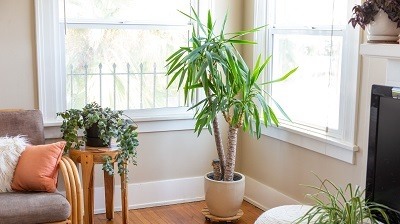
Yucca cane plants are native to Mexico and Guatemala. These indoor trees have thick and sturdy trunks for displaying dramatic sword-sharp foliages.
The upright burst of leaves helps create a stylish and contemporary appeal. The plant can tolerate high humidity, average indoor temperature, and cold conditions.
| Maximum Height | 9-14ft |
| Light Requirements | Low light |
| Water Requirements | Moist soil |
| Indoor Benefits | Bring a contemporary look indoors. |
| Native | Mexico and Guatemala |
Fiddle Leaf Fig (Ficus Lyrata)
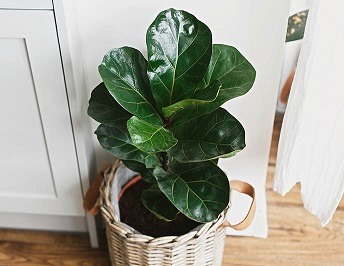
The fiddle leaf fig tree has an upright trunk with large glossy leaves having criss-cross venations. This beautiful violin-shaped leaf plant can mark a bold statement in your living space.
The plant hails from the tropical rainforest of western and central Africa. It prefers a consistently warm and humid environment. We also recommend rotating the indoor fiddle leaf fig to prevent stems from bending.
| Maximum Height | 6-10ft |
| Light Requirements | Low to moderate light |
| Water Requirements | Moist soil |
| Indoor Benefits | Decorative appeal |
| Native | Western and Central Africa |
Bamboo Palm (Chamaedorea Seifrizii)
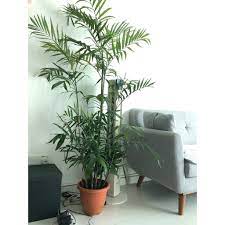
Bamboo palm features thick upright tan stalks with multiple dark green feathery fronds to create a tropical appeal to your indoor space.
These palm trees are native to the Montana forest of Central America. We recommend rotating indoor bamboo palms weekly for the sunlight to penetrate the dense leaves.
| Maximum Height | 5-10ft |
| Light Requirements | Low to moderate |
| Water Requirements | Moist soil |
| Indoor Benefits | Tropical appeal |
| Native | Montana forest of Central America |
Dwarf Banana Tree (Musa Acuminate)
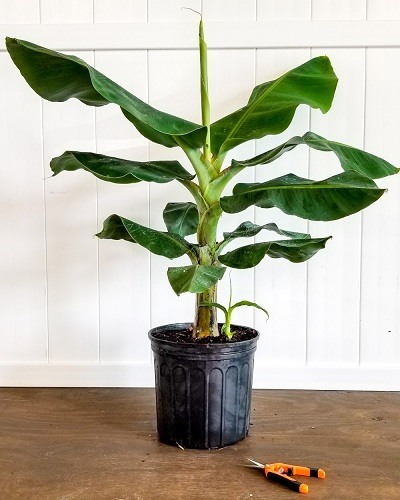
The dwarf banana tree is another perfect choice for a small indoor space. It hails from the south pacific and Southeast Asia.
The banana tree features oversized paddle-shaped leaves with slightly ruffled edges and purple blotches. But these purple botches disappear at maturity.
| Maximum Height | 6-9ft |
| Light Requirements | Low light |
| Water Requirements | Moist soil |
| Indoor Benefits | Tropical forest vibe |
| Native | South Pacific and Southeast Asia |
Areca Palm (Dypsis Lutescens)
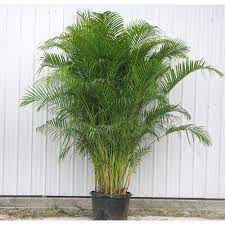
It has slender silvery-green stalks clustered to produce beautiful layers of feathery leaves with curving stems.
Areca palms are native to Madagascar due to the mid-high humidity levels. The palm thrives in warm temperatures and loves a moderate watering routine.
| Maximum Height | 4-8ft |
| Light Requirements | Moderate to low light |
| Water Requirements | Moist soil |
| Indoor Benefits | Aesthetic appeal |
| Native | Madagascar |
Weeping Fig (Ficus Benjamin)
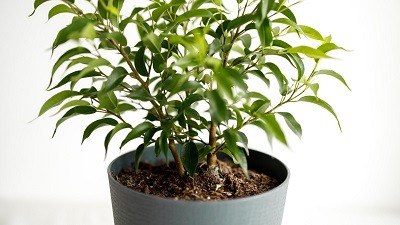
The weeping willow-like appearance of delicate stems adorned with narrow leaves is the reason behind its name. It comes in dark green or variegated with white margins.
Weeping figs are native to Asia and Australia. The arrow-shaped leaves are vulnerable to dropping due to unstable environmental conditions.
Avoid moving the plant more often and keep it away from drafty areas. Weeping fig is also known as ficus, java fig, or Benjamin fig.
| Maximum Height | 6ft |
| Light Requirements | Low to moderate |
| Water Requirements | Moist soil |
| Indoor Benefits | Improve decor |
| Native | Asia and Australia |
My Final Thoughts
Shopping for low-light indoor trees can be a daunting experience for beginners and season houseplant enthusiasts. Remember that low-lighting conditions can make the leaves drop or inhibit the plant from flowering.
We hope this information about low-light non-toxic indoor trees will help you make an informed decision before buying. Feel free to share with your friends or family members and let us know your views in the comment section.
Readers Who Read This Also Read:
